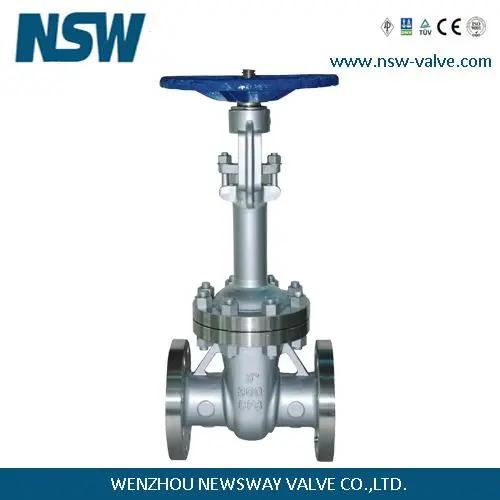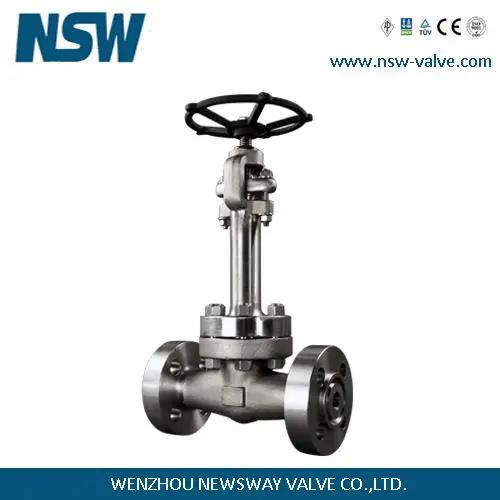
Products
Cryogenic Ball Valve Extended Bonnet for -196℃
✧ Description
Cryogenic ball valves with extended bonnets suitable for operating at temperatures as low as -196°C are specially designed to handle the extreme conditions of cryogenic applications. These valves are commonly used in industries such as LNG (liquefied natural gas) processing, industrial gas production, and other cryogenic fluid handling applications.Key features of cryogenic ball valves with extended bonnets for -196°C include:Low-Temperature Materials: The valves are typically constructed from specialized materials such as stainless steel, carbon steel, or other alloys with low-temperature properties to ensure performance and integrity in cryogenic environments.Extended Bonnet Design: The extended bonnet provides additional insulation and protection for the valve stem and packing to maintain proper functioning at extremely low temperatures.Sealing and Packing: The valve's sealing components and packing are specifically designed to remain effective and flexible at cryogenic temperatures, enabling tight shut-off and preventing leakage.Testing and Compliance: These valves undergo rigorous testing to ensure performance and compliance with industry standards for cryogenic service.Operational Safety: Cryogenic ball valves with extended bonnets are crucial for maintaining safe and reliable control of cryogenic fluid flows, contributing to operational safety in cryogenic systems.When selecting cryogenic ball valves for -196°C applications, it's important to consider factors such as material compatibility, pressure and temperature ratings, and compliance with relevant industry standards and regulations.
✧ Features of Cryogenic Ball Valve Extended Bonnet for -196℃
API 6D trunnion ball valve is a ball valve product that meets the requirements of American Petroleum Institute standard API 6D. This standard stipulates the design, material, manufacturing, inspection, installation and maintenance requirements of API 6D trunnion ball valves to ensure the quality and reliability of ball valves, and is suitable for various industrial fields such as oil and gas. Features of API 6D trunnion ball valve include:
1.The full bore ball is used to reduce the pressure drop of the valve and improve the flow capacity.
2.The valve adopts a two-way sealing structure with good sealing performance.
3.The valve is easy to operate and smooth, and the handle is marked for easy identification by the operator.
4.The valve seat and sealing ring are made of high-temperature, high-pressure and corrosion-resistant materials, which are suitable for various fluid media.
5. The parts of the ball valve are well separable, easy to install and maintain. API 6D trunnion ball valves are suitable for occasions in the industrial field that need to control fluid flow, cut off fluid, and maintain pressure stability, such as fluid piping systems in petroleum, chemical, natural gas, water treatment and other fields.
✧ Parameters of Cryogenic Ball Valve Extended Bonnet for -196℃
| Product | Cryogenic Ball Valve Extended Bonnet for -196℃ |
| Nominal diameter | NPS 2”, 3”, 4”, 6”, 8”, 10”, 12”, 14”, 16”, 18”, 20”, 24”, 28”, 32”, 36”, 40”, 48” |
| Nominal diameter | Class 150, 300, 600, 900, 1500, 2500. |
| End Connection | Flanged (RF, RTJ), BW, PE |
| Operation | Handle Wheel, Pneumatic Actuator, Electric Actuator, Bare Stem |
| Materials | Forged: A105, A182 F304, F3304L, F316, F316L, A182 F51, F53, A350 LF2, LF3, LF5 |
| Casting: A216 WCB, A351 CF3, CF8, CF3M, CF8M, A352 LCB, LCC, LC2, A995 4A. 5A, Inconel, Hastelloy, Monel | |
| Structure | Full or Reduced Bore, |
| RF, RTJ, BW or PE, | |
| Side entry, top entry, or welded body design | |
| Double Block & Bleed (DBB),Double Isolation & Bleed (DIB) | |
| Emergency seat and stem injection | |
| Anti-Static Device | |
| Design and Manufacturer | API 6D, API 608, ISO 17292 |
| Face to Face | API 6D, ASME B16.10 |
| End Connection | BW (ASME B16.25) |
| MSS SP-44 | |
| RF, RTJ (ASME B16.5, ASME B16.47) | |
| Test and Inspection | API 6D, API 598 |
| Other | NACE MR-0175, NACE MR-0103, ISO 15848 |
| Also available per | PT, UT, RT,MT. |
| Fire safe design | API 6FA, API 607 |
✧ After Sale Service
The after-sales service of the floating ball valve is very important, because only timely and effective after-sales service can ensure its long-term and stable operation. The following are the after-sales service contents of some floating ball valves:
1.Installation and commissioning: After-sales service personnel will go to the site to install and debug the floating ball valve to ensure its stable and normal operation.
2.Maintenance: Regularly maintain the floating ball valve to ensure that it is in the best working condition and reduce the failure rate.
3.Troubleshooting: If the floating ball valve fails, the after-sales service personnel will carry out on-site troubleshooting in the shortest possible time to ensure its normal operation.
4.Product update and upgrade: In response to new materials and new technologies emerging in the market, after-sales service personnel will promptly recommend update and upgrade solutions to customers to provide them with better valve products.
5. Knowledge training: After-sales service personnel will provide valve knowledge training to users to improve the management and maintenance level of users using floating ball valves. In short, the after-sales service of the floating ball valve should be guaranteed in all directions. Only in this way can it bring users a better experience and purchase safety.





